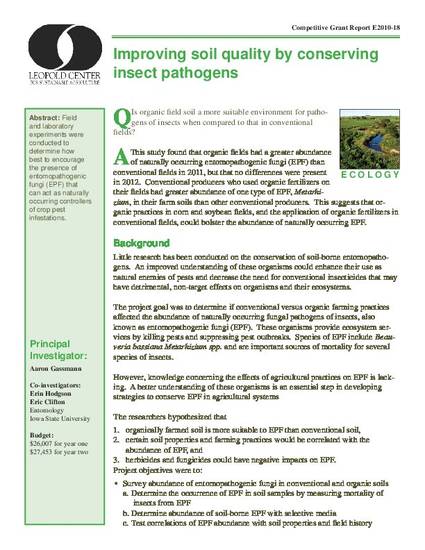
Article
Improving soil quality by conserving insect pathogens
Leopold Center Completed Grant Reports
Project ID
E2010-18
Abstract
This study found that organic fields had a greater abundance of naturally occurring entomopathogenic fungi (EPF) than conventional fields in 2011, but that no differences were present in 2012. Conventional producers who used organic fertilizers on their fields had greater abundance of one type of EPF, Metarhizium, in their farm soils than other conventional producers. This suggests that organic practices in corn and soybean fields, and the application of organic fertilizers in conventional fields, could bolster the abundance of naturally occurring EPF.
Key Question
Is organic field soil a more suitable environment for pathogens of insects when compared to that in conventional fields?
Findings
This study found that organic fields had a greater abundance of naturally occurring entomopathogenic fungi (EPF) than conventional fields in 2011, but that no differences were present in 2012. Conventional producers who used organic fertilizers on their fields had greater abundance of one type of EPF, Metarhizium, in their farm soils than other conventional producers. This suggests that organic practices in corn and soybean fields, and the application of organic fertilizers in conventional fields, could bolster the abundance of naturally occurring EPF.
Principal Investigator(s)
Aaron Gassmann
Co-Investigator(s)
Erin Hodgson, Eric Clifton
Year of Grant Completion
2013
Disciplines
Citation Information
Aaron J. Gassmann, Erin W. Hodgson and Eric H. Clifton. "Improving soil quality by conserving insect pathogens" (2013) Available at: http://works.bepress.com/erin_hodgson/197/
